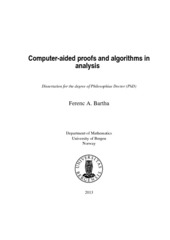| dc.description.abstract | The computational power has increased dramatically since the appearance of the first computers, making them a vital tool in the analysis of dynamical systems. We present further applications of those two basic ideas, namely interval arithmetic and automatic differentiation, that address the question of the reliability of the results and the difficulty of calculating derivatives. In general, the result of a numerical calculation will be influenced by errors, since the set of the numbers represented by the machine is finite. This will inevitably lead to round-off and truncation errors. This should not be considered as a problem, but rather as the true nature of numerics. The notorious examples like evaluating 333.75y6+ x2(11x2y2−y6−121y4−2)+5.5y8+x/(2y) at (x, y) = (77617,33096) or plotting the polynomial t6 −6t5 +15t4 −20t3 +15t2 −6t +1 in a small neighborhood of 1, still result in unexpected outcomes, if one is unaware of the potential risks of the floating point computations. We mention the failure of a Patriot missile on February 25, 1991 or the explosion of the unmanned space rocket Ariane 5 on June 4, 1996 as practical examples of these potential risks becoming real. Therefore in mathematical proofs, where the beauty of the argument is its unquestionable truth itself, the usage of computers must be handled with extreme care. One technique, that is used to overcome these problems and make our computations rigorous, is called interval arithmetic. To calculate derivatives of a given function is often considered to be a hard problem, since in general with increasing the order or the dimension, the complexity of the formula of the derivative grows exponentially. The observation, that we do not need these formulae in general, but only certain values of the derivatives, is crucial to understand why automatic differentiation is so useful. The structure of the thesis is as follows. In Part I we give an introduction to the methods used in our papers. In Chapter 1 we get acquainted with the basic techniques, interval arithmetic, interval analysis, floating point computations and automatic differentiation. Chapter 2 gives an overview of the interaction between dynamical systems and different representations of the data. In Chapter 3 we take on the basic concept of automatic differentiation seen before, and present a method by Griewank et al. [17] to compute higher order derivatives of multivariate functions that will be used in Paper A. We go through the theory of graph representations in Chapter 4 by following the steps of Hohmann and Dellnitz [12] and Galias [15]. This theory may be used in qualitative analysis of maps. We give two applications in Paper B and Paper C. In addition, we give the proof of correctness of the algorithm for enclosing non-wandering points in Paper B. In Chapter 5 we introduce the reader to the method of self-consistent bounds by Zgliczy´nski and Mischaikow [44] and Zgliczy´nski [40, 42, 43] that may be used to analyze a certain class of dissipative partial differential equations. An application of this concept to a destabilized Kuramoto-Sivashinsky equation is given in Paper D. Chapter 6 gives a short overview of the results of the included papers. Part II is the main scientific contribution of this thesis, consisting of the formerly mentioned four papers. | en_US |
